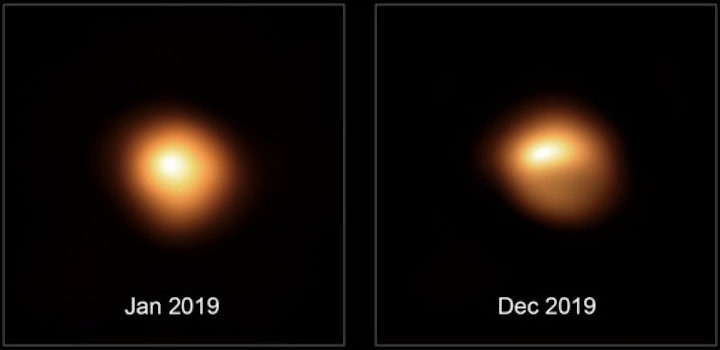New before and after photos taken by SPHERE (Spectro-Polarimetric High-contrast Exoplanet REsearch Instrument) on the European Southern Observatory’s Very Large Telescope (VLT) show not only how much the star has faded but also that its shape has changed. A team led by astronomer Miguel Montargès, of KU Leuven in Belgium, has been observing the star since December with the VLT and released these stunning images just today (February 14th). Montargès suspects that Betelgeuse's dramatic fading may be due either a cooling of the surface or dust ejected by the star in our direction.

This infrared image, obtained with the VISIR instrument on the VLT, shows the immensity of the patchy dust clouds surrounding Betelgeuse in December 2019. The clouds form when the star sheds its material back into space. The black disk masks the star and its immediate surroundings thus revealing the fainter dust plumes. The orange dot in the middle is the SPHERE image of Betelgeuse’s surface, which in size is close to that of Jupiter’s orbit.
ESO / P. Kervella / M. Montargès et al. / Acknowledgement: Eric Pantin
Dust is a great absorber of starlight, and Betelgeuse with its powerful stellar winds produces oodles of the stuff. This dust fills an enormous circumstellar shell that dwarfs the star itself. A massive red supergiant like Betelgeuse possesses a relatively cool atmosphere in which elements forged by the star combine to form the chemical compounds that make up the dust. Astronomers have identified water, silicon monoxide, and aluminum oxide among other molecules in the star's effluent.
Amateur and professional astronomers around the planet have kept a close watch on Betelgeuse during its dramatic "fainting" over the past several months. For some it's more like a deathwatch. I've run into more than a few people expecting or hoping that the famous supergiant will explode as a supernova. Hold your horses! We'd all like to be dazzled by a –11 magnitude supernova, I tell them, but we just don't know enough to start circling dates on a calendar.

An imaginary depiction of Betelgeuse should it one day explode as a supernova. It will peak at around magnitude –11 — as bright as the gibbous Moon!
Edward Guinan
Betelgeuse has remained around magnitude 1.6 (or 1.7 by my visual estimate) for the past couple weeks. Gazing at the star these February nights, it's hard to believe that at peak brightness it can outshine its fellow luminary Rigel. At the moment, Betelgeuse and its mate Bellatrix (magnitude 1.6) are virtually equal in brightness, while Aldebaran (0.9) in nearby Taurus overpowers the supergiant by three-quarters of a magnitude. Guinan's photometric observations over the past week show Betelgeuse at around 1.60 to 1.62 — the least luminous and coolest yet measured during 25 years of photometry.

Ten years of photometric data not only reveal Betelgeuse's routine ups and downs but also its current remarkable minimum.
Edward Guinan

Betelgeuse declined in brightness slowly beginning about four months ago, then quickened and now appears to be slowing down (right).
Edward Guinan
Light variations on Betelgeuse arise in several ways: the aforementioned episodes of dust ejection; physical pulsations that cause the star to expand and contract at regular and irregular intervals and darkening caused by jumbo-sized starspots on the star's surface. Guinan bases the February 21st date on the star's dominant pulsation period of 430 days, which arrives on or about that date.

Twenty-three years of period analysis of Betelgeuse reveals that the star's brightness varies with multiple periods but dominated by those of 430 days and ~6 years. Imagine if you had five different pulse rates!
Edward Guinan
An analysis of Betelgeuse's light variations reveals evidence for multiple periods of variation from as brief as around 242 days to as long as 6.06 years. It's a splendid mess and the reason more and more professional astronomers are scrutinizing it with every instrument they can get their hands on.
Guinan and a team other other scientists were recently awarded time to observe the supergiant with NASA's Stratospheric Observatory for Infrared Astronomy (SOFIA) in mid-infrared high-resolution spectroscopy. Many more efforts are underway including but not limited to Hubble Space Telescope near-infrared observations, 22-GHz and 15-GHz radio studies with e-MERLIN (the enhanced Multi Element Remotely Linked Interferometer Network), and the Arcminute Microkelvin Imager (AMI), along with interferometric measurements (to determine the star's size and shape) using VLTI-SPHERE and CHARA.
Your efforts count, too! Amateur astronomers like you have contributed hundreds of recent visual, CCD, and photoelectric observations of the star to the American Association of Variable Star Observers (AAVSO).

Beastly big! This image, made with the Atacama Large Millimeter/submillimeter Array (ALMA), depicts the red supergiant Betelgeuse placed at the center of our solar system. With a diameter some 1,400 times larger than the Sun, it would envelop all the inner planets as well as Jupiter.
ESO
Betelgeuse remains in view until May, so there's lots of time for the star to either resume its routine or confound us with more surprises. We all have a front seat at this show. Walter Webb of the Red River Astronomy Club in Texas wonders if NASA might be able to use the Mars Curiosity Rover to extend observations of the star though solar conjunction from Gale Crater. Great suggestion!

Use this photo to help you estimate the brightness of Betelgeuse. Magnitudes are shown for Bellatrix and Aldebaran.
Bob King
One thing is clear: Betelgeuse called out, and now we're listening with every ounce of ingenuity we can muster. And if you're still hungry for a supernova, have a look at SN 2020 ue in NGC 4636 in Virgo. It still shines around magnitude 12, an easy catch in an 8-inch or larger telescope. Click here for a finder chart and more information.

